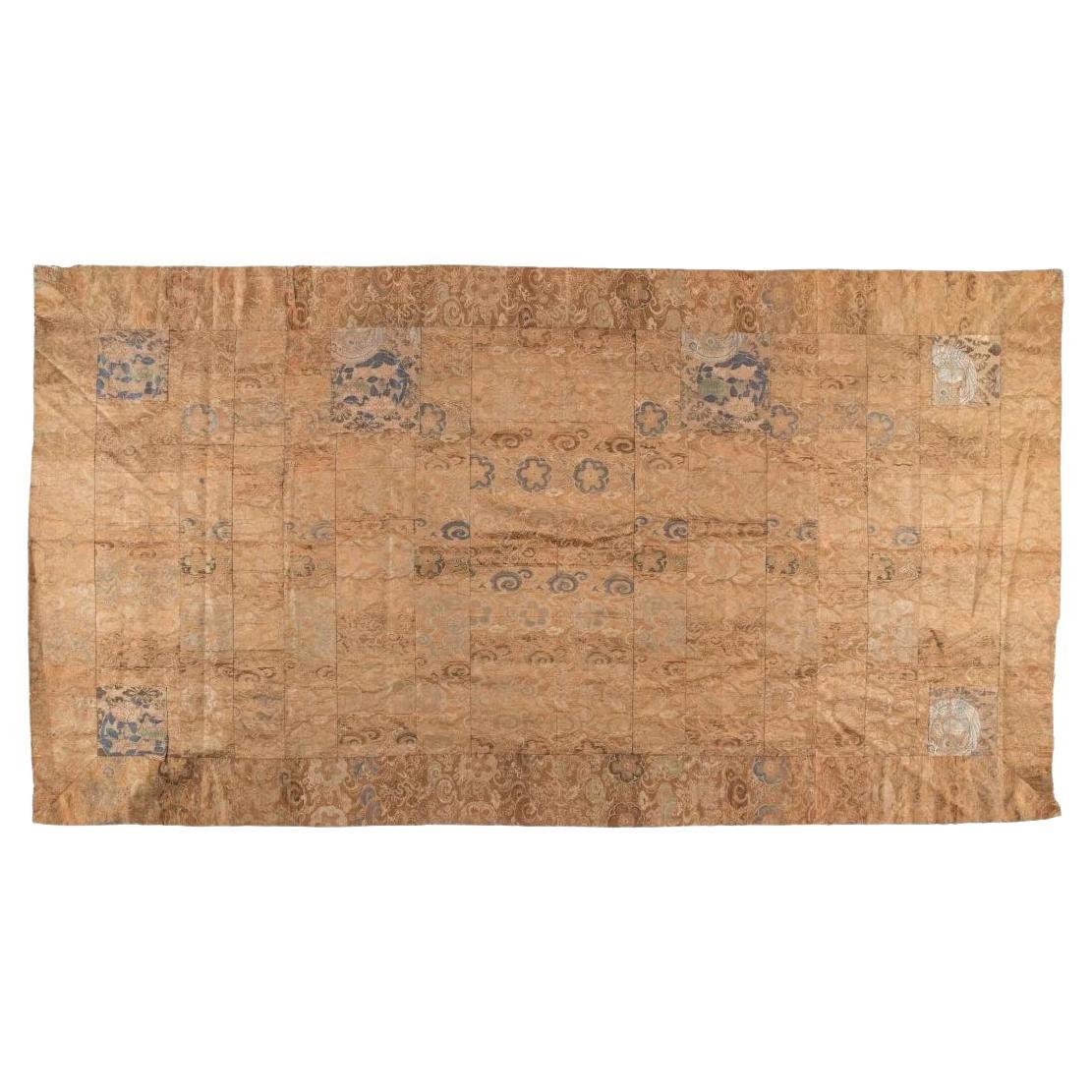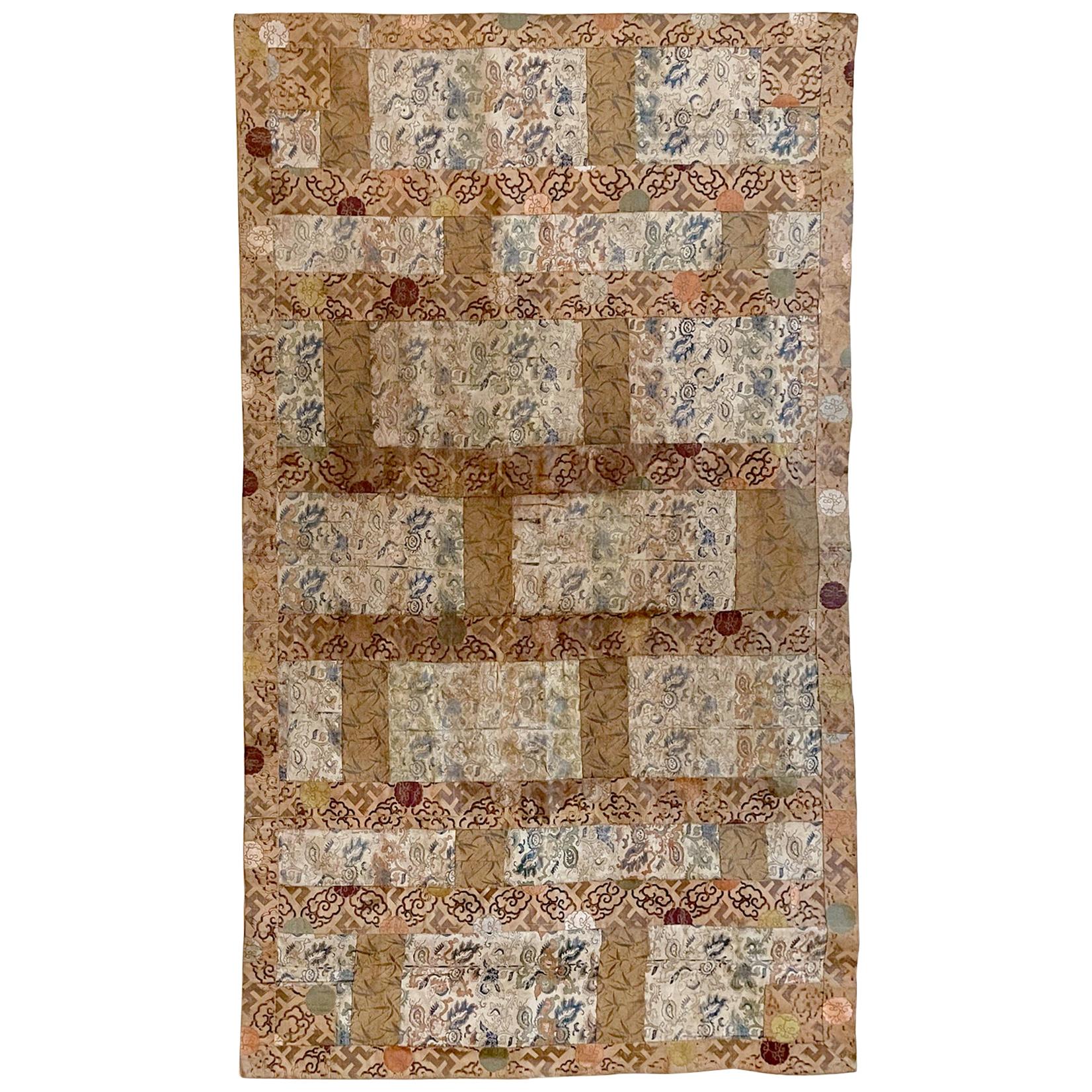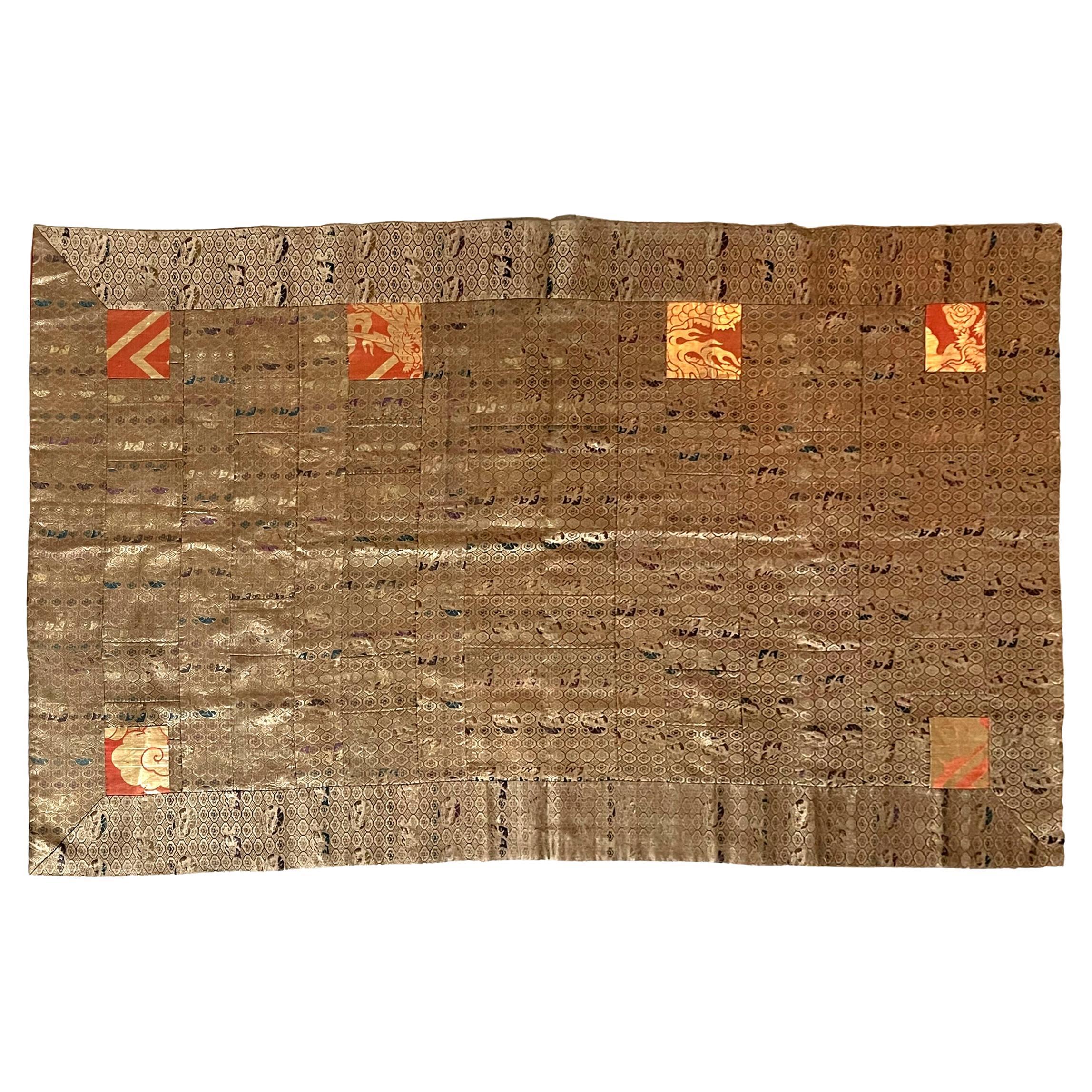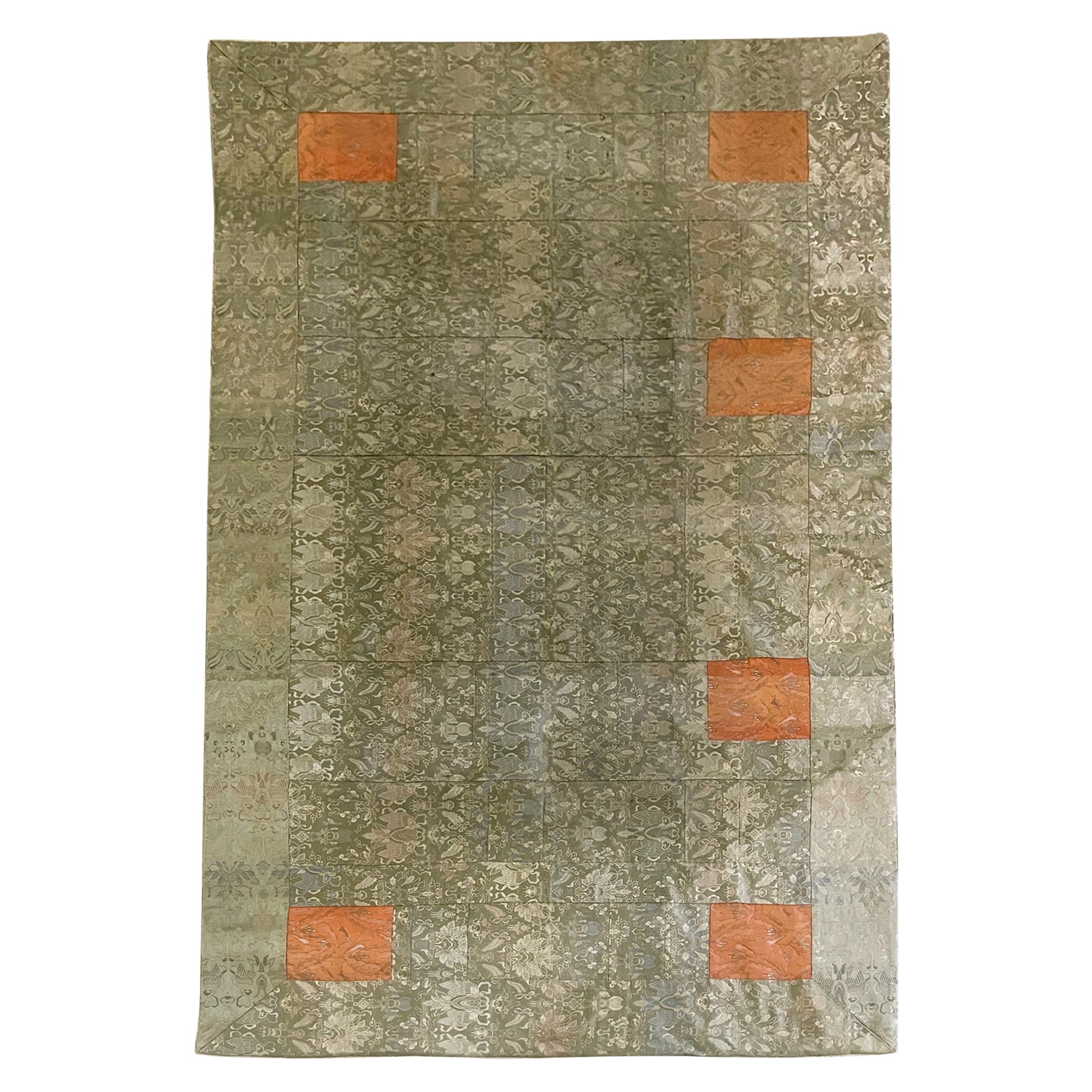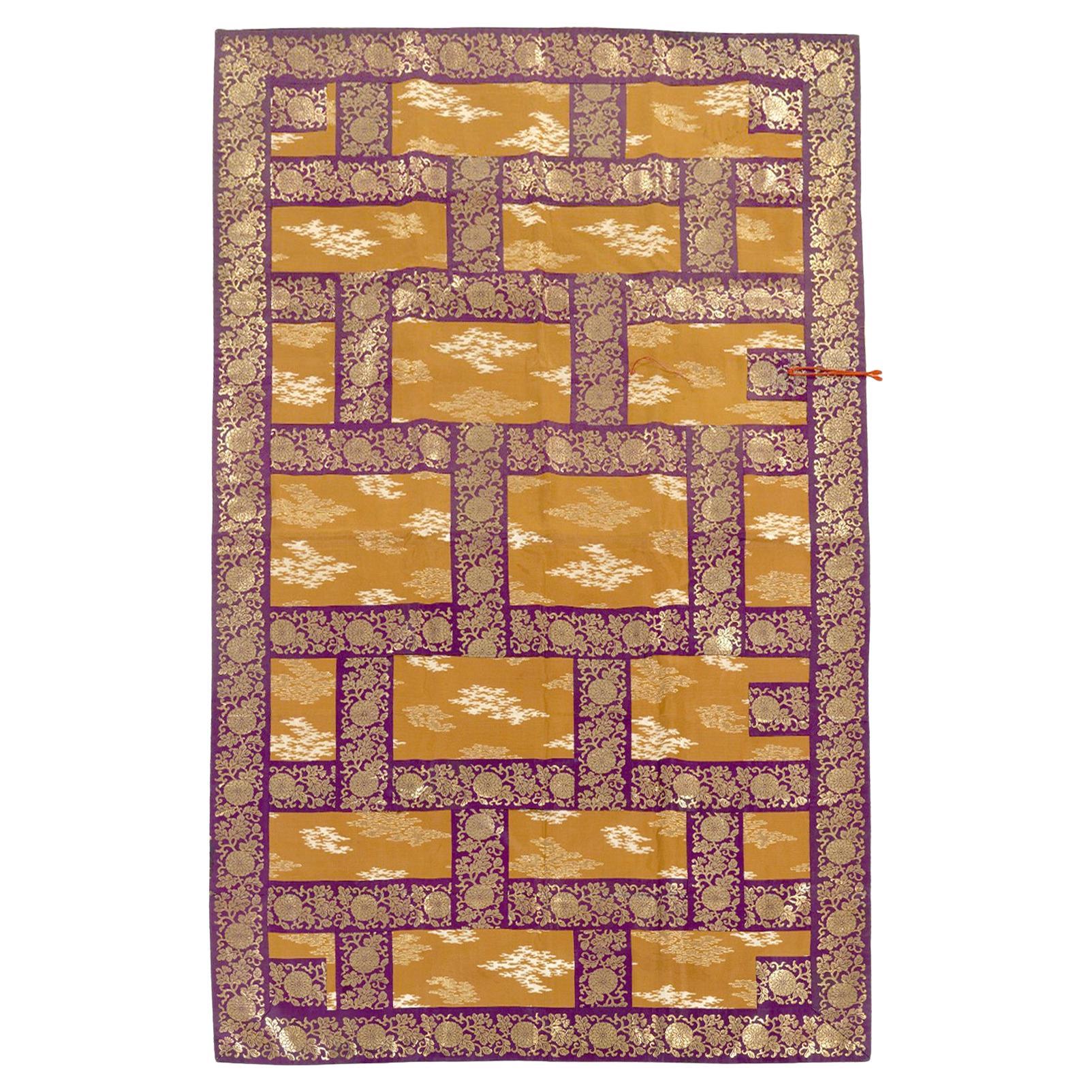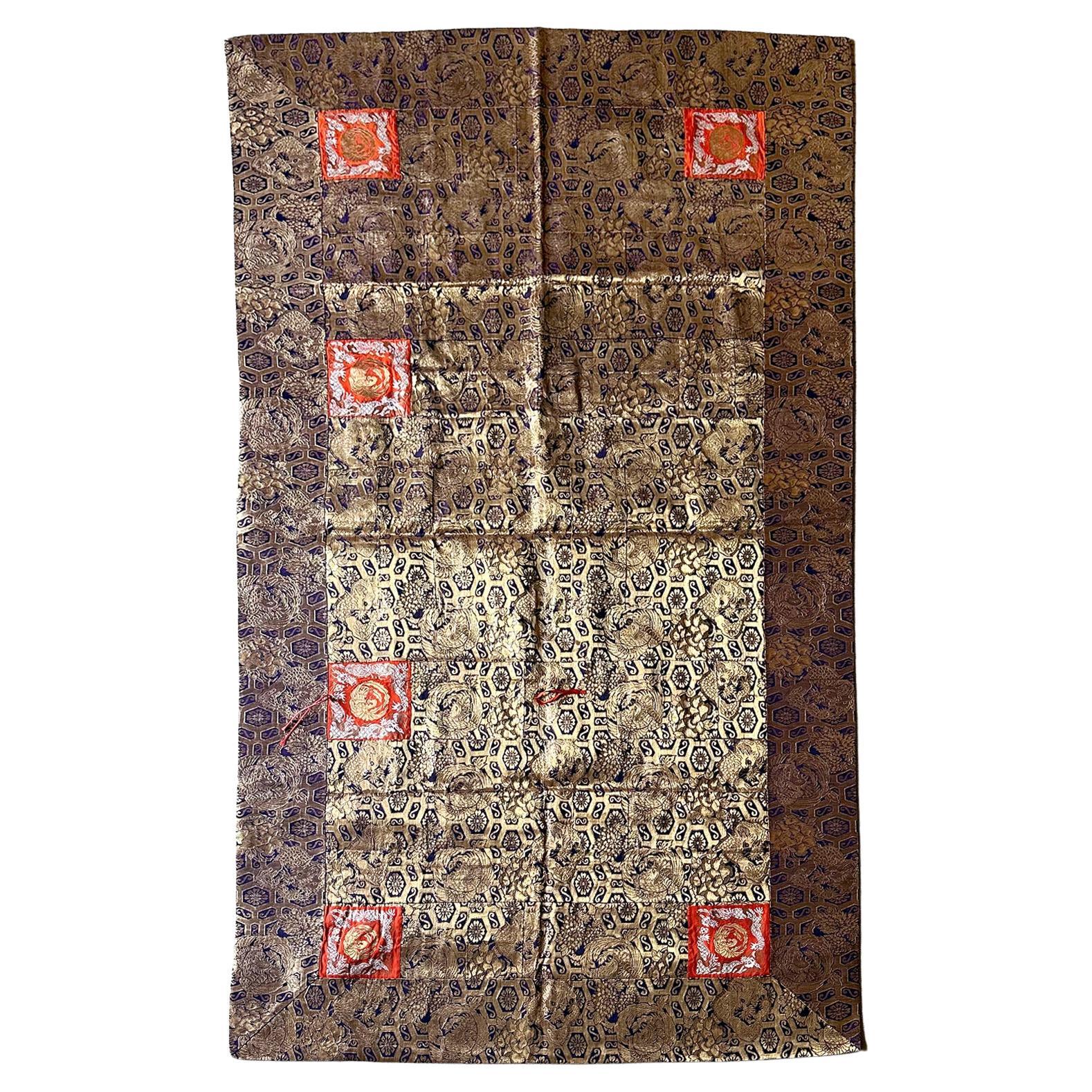Items Similar to Antique Japanese Embroidered Silk Kesa Monk's Robe Edo Period
Want more images or videos?
Request additional images or videos from the seller
1 of 17
Antique Japanese Embroidered Silk Kesa Monk's Robe Edo Period
About the Item
A Japanese Kesa (Monk's Vestment) made from thirteen columns of patchworks of fine shimmering silk fabric of a salmon orange color, the shade of which changed subtly from different angles of light, Fine and delicate embroidery work of two family-mons form repetitive patterns in rows and lines permeating the entire surface. The motifs various in detailed use of threads in contrasting colors to create a positive and negative mirror effect between them. Five silk square in contrasting white color with brown woven vines were sewn to the four corners and one on the longitude side of the Kesa, completing the symbolism of the robe. The four squares in the corners represent the Four Heavenly Kings (Shi Tenno); while the square in the middle section with a tie represent a compassionate bodhisattva (traditionally there are two squares, but on this kesa only one was used. The Kesa has no lining, exposed the intricate needle work on the back as shown.
Kesa is derived from the Sanskrit word kasaya, meaning “dark colored,” a reference to the saffron colored robes worn by early Indian Buddhist monks. It is essentially a rectangular cloth originally sewn from patches of rags, being formless, it serves as a symbolism of the ascetic life of one's choosing. In Japan, since at least the Heian period (794–1185), the kesa has been worn by Buddhist priests as their outermost robe, draped over the left shoulder and attached under the right armpit. While it served some function of protection, it was more a signal of the wearer’s faith, and became increasingly elaborate over the centuries. During the Edo period (1600–1868), many kesa worn were patched together from exquisite silk brocade fabrics that were donated to the temples by members of the aristocracy, ruling military class, or wealthy merchants. By stitching the fabric into a patchwork robe, the monks concentrated their attention on the creation of a devotional work of art, every stitch part of an act of meditation on the teachings of the Buddha. The number of stripes (from 5 to up to 25) indicates the wearer’s rank and the occasion for which it was worn, the highest number of stripes usually only being worn by an abbot during festival ceremonies. The normal daily kesa generally have seven columns. The kesa on offer is more likely a ceremonial robe for special occasion.
- Dimensions:Height: 47 in (119.38 cm)Width: 82.25 in (208.92 cm)Depth: 0.1 in (2.54 mm)
- Style:Edo (Of the Period)
- Materials and Techniques:
- Place of Origin:
- Period:
- Date of Manufacture:19th century
- Condition:Wear consistent with age and use. Good antique textile condition with fine work and shimmering colors. Some small losses and minor frays on the edges. Unlined. Unframed.
- Seller Location:Atlanta, GA
- Reference Number:1stDibs: LU945039168922
About the Seller
5.0
Platinum Seller
These expertly vetted sellers are 1stDibs' most experienced sellers and are rated highest by our customers.
Established in 2006
1stDibs seller since 2010
479 sales on 1stDibs
Typical response time: <1 hour
- ShippingRetrieving quote...Ships From: Atlanta, GA
- Return PolicyA return for this item may be initiated within 2 days of delivery.
More From This SellerView All
- Antique Japanese Brocade Kesa Monk's Robe Edo PeriodLocated in Atlanta, GAA Japanese Kesa (Monk's Vestment) made from thirteen columns of patchworks of shimmering woven brocades. The elaborate motifs feature repetitive hibiscus flowers within framework of ...Category
Antique 19th Century Japanese Edo Textiles
MaterialsBrocade, Silk
- Antique Brocade Kesa Monk's Patched Robe Edo PeriodLocated in Atlanta, GAKesa, known as "Jiasha" in Chinese and "Kasaya" in Sanskrit, is an out layer garment worn by the ordained Buddhist monks. Bearing a basic rectangular form, it developed originally in...Category
Antique Late 18th Century Japanese Edo Textiles
MaterialsTextile, Brocade
- Antique Japanese Brocade Kesa Monk's Robe Meiji PeriodLocated in Atlanta, GAA stunning Japanese Kesa (Monk's Vestment) made from thirteen columns of patchworks of shimmering woven brocades. The elaborate motifs feature repetitive...Category
Antique Late 19th Century Japanese Meiji Textiles
MaterialsBrocade, Silk
- Antique Japanese Brocade Monk's Robe Kesa Meiji PeriodLocated in Atlanta, GAA Japanese Kesa (Monk's Vestment) made from thirteen columns of patchworks of shimmering woven brocades. The elaborate motifs feature repetitive elaborat...Category
Antique Late 19th Century Japanese Meiji Textiles
MaterialsBrocade, Silk
- Antique Silk Kesa Monk's Patched Robe Meiji PeriodLocated in Atlanta, GAKesa, known as "Jiasha" in Chinese and "Kasaya" in Sanskrit, is an out-layer garment worn by the ordained Buddhist monks. Bearing a basic rectangular form, it developed originally in...Category
Antique 19th Century Japanese Meiji Textiles
MaterialsTextile, Brocade
- Magnificent Antique Japanese Woven Brocade Kesa Monk's Robe Meiji PeriodLocated in Atlanta, GAA stunning Japanese Kesa (Monk's Vestment) made from thirteen columns of patchworks of shimmering woven brocades with luxuriant golden threads. Dated to late 19th century of Meiji Period, the elaborate woven motifs on this kesa feature repetitive roundels dragon and phoenix intermixed with peonies and chrysanthemum blossoms. Two shades of contrasting gold threads were used on a striking purplish-blue background, with a dark metallic thread for the outer border and a brighter thread for the main body. The brilliantly woven fabric was possibly recycled from Noh costumes...Category
Antique Late 19th Century Japanese Meiji Textiles
MaterialsBrocade, Silk
You May Also Like
- 19th Century Chinese Embroidered Silk Ladies Butterfly Short RobeLocated in Chicago, ILWhen the Qing-dynasty woman who wore this lovely jacket entered a room, people would instantly have recognized her status and rank based on the materials and decoration of her garmen...Category
Antique Mid-19th Century Chinese Qing Textiles
MaterialsSilk
- Antique Chinese Chinoiserie Silk Embroidered Floral Panel Table RunnerLocated in Dayton, OHLarge antique framed Chinese black silk folk art textile / tapestry panel or table runner embroidered with brown, gold and blue flowers / leaves. ...Category
Early 20th Century Chinoiserie Textiles
MaterialsSilk
- Antique Joseon Dynasty Embroidered Silk Textile Floral Bird Vase Calligraphy 31"Located in Dayton, OHAntique Joseon Dynasty (possibly Li Dynasty period) needlepoint textile silk showing a blue water vase decorated with a peacock and flowers, with calli...Category
Late 20th Century Chinoiserie Textiles
MaterialsSilk, Rosewood
- Late Meiji Period Sleeping Kimono / Yogi, JapanLocated in Point Richmond, CALate Meiji Period sleeping Kimono / Yogi, Japan Yogi are a type of oversized sleeping kimono traditionally used in Japan. This kimono would have b...Category
Early 20th Century Japanese Tribal Textiles
MaterialsCotton
- Antique Embroidered Chinese Wall HangingLocated in Delray Beach, FLThis is an incredible wall hanging made of embroidered silk satin. An antique piece from China, the traditional motifs show repeated scene of dragons and birds in perfect detail in p...Category
Antique 19th Century Chinese Tapestries
MaterialsSilk
- Antique Early 20th Century Japanese Hand Stitched Silk Framed TapestryLocated in Lambertville, NJAll hand work framed silk Japanese tapestry with embroidered boarder. A deep custom black lacquered frame. Originaly sold from Newman Galleries....Category
Early 20th Century Japanese Meiji Textiles
MaterialsSilk, Glass, Lacquer
Recently Viewed
View AllMore Ways To Browse
Tucuman Tapestry
Marble Top Circular Center Table
Claw Ball Feet Chair
Dining Room Set Table 8 Chairs
Chest Military Chest
Low Iron Glass
Peach Contemporary Rugs
Deco Spring Chair
Dark Stained Side Table
Two Panel Room Divider
Bistro Table Top
19th Century Persian Textiles
Country Wood Benches
Antique Cabinet With Sliding Doors
Corner Knobs
Hanging Plate Set
Italian Console Table Long
Sculptural Wood Pendant
